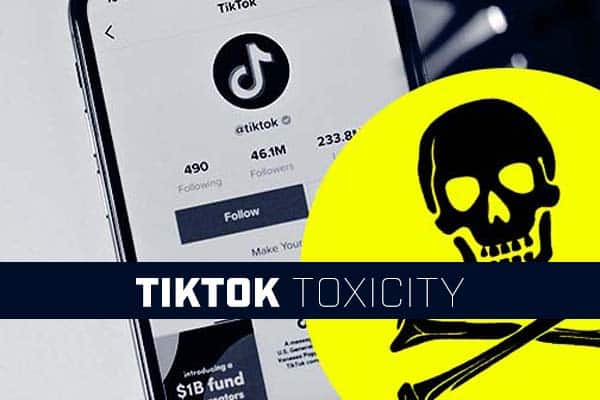TikTok Toxicology

Since its North American debut in 2018, TikTok has dominated the teenage social media market. In 2022, a survey reported that 67% of American teenagers have used TikTok and 16% report use multiple times a day.[1] With its 60 to 120 second videos, TikTok allows users to record and upload video clips on almost any possible subject, from educational to silly, heartwarming to hilarious. As with any social media platform, TikTok also has a dangerous side that has landed followers in the hospital. TikTok challenges, which have also been shown on other social media sites such as Facebook and Instagram, are short video clips of people performing a stunt or a dance, singing a song, or using a trendy filter. However, the TikTok challenge can sometimes turn deadly.
One challenge involves participants taking copious amounts of diphenhydramine (Benadryl) in order to get high on camera. At high doses, the antihistamine causes hallucinations, delirium, seizures, coma, and cardiac arrest. Patients commonly present in one of two ways: sedation and coma, or on the other hand, extreme agitation. Patients who are extremely agitated may be hallucinating, picking at their bedsheets or clothes, and combative. Like other anticholinergics, diphenhydramine blocks the binding of the neurotransmitter acetylcholine at the muscarinic receptors. These receptors are found in the central nervous system as well as smooth muscles, sweat glands, salivary glands, and ciliary body of the eye.[2] Providers can remember the signs of anticholinergic toxicity with the popular phrase, “Red as a beet, dry as a bone, blind as a bat, mad as a hatter, hot as a hare, full as a flask.” This refers to the signs and symptoms of anticholinergic toxicity: flushing, dry mucous membranes, dilated pupils, altered mental status, fever, and urinary retention. As diphenhydramine overdoses can cause wide complex tachycardia and QT prolongation, providers should carefully monitor the cardiac rhythm as well. Care for these patients is generally supportive and based on symptoms with IV fluids, benzodiazepines if necessary for agitation, cardiac monitoring, cooling measures for hyperthermia, and urinary catheter placement.
For the Nutmeg Challenge, users will record themselves taking two to four tablespoons of nutmeg and the subsequent high. A common spice used for thousands of years and easily accessible, nutmeg can cause significant psychiatric and neurological symptoms at high doses. The chemical Myristicin is considered to be the primary culprit in the CNS effects that Nutmeg can cause, as it has been found in rats to be a central monoamine oxidase (MAO) inhibitor.[3] This may cause a plethora of symptoms, including hallucinations, anxiety, euphoria, agitation, confusion, incoherent speech, and altered mental status including unresponsiveness. Symptoms generally begin within three to six hours of ingestion but can be as short as 30 minutes, and often last between 12 and 24 hours. Some patients may develop serious complications such as hyponatremia, elevated creatine kinase, and leukocytosis with neutrophilic.[4] As there is no antidote or cure for nutmeg poisoning, care is supportive and symptom based. Benzodiazepines may be used to reduce some of the agitation and anxiety. As with all overdoses, respiratory and cardiac functioning should be closely monitored.
While many TikTok challenges may result in discomfort and a need for close monitoring, most are not deadly in nature. The latest challenge is likely one of the more dangerous ones out there. The “challenge”, often couched as a home remedy for upper respiratory infections, involves eating a boneless chicken breast cooked in a bottle of NyQuil or similar medication. Unsurprisingly, the FDA issued a warning about the dangers of cooking anything in NyQuil, citing the effects of acetaminophen, dextromethorphan, and doxylamine succinate—the three main ingredients found in the medication. The FDA also warns about the dangers of boiling a medication, which can make the resulting liquid more concentrated and change the properties of the ingredients. Inhaling the vapors can also cause high levels of the ingredients to enter the lungs, potentially causing further damage to the body.[5] Acetaminophen is particularly worrisome, as acetaminophen overdose is the leading cause of severe acute liver failure in the Western world.[6] Metabolism causes a toxic byproduct, N-acetyl-p-benzoquinone imine, or NAPQI. Acetaminophen causes liver damage when the glutathione pathway becomes overwhelmed by too much of the NAPQI that the drug metabolizes into. When there is no more glutathione, the NAPQI reacts with the liver cells, killing them and causing hepatoxicity. While NAPQI is usually produced in small amounts that the liver detoxifies, in the case of an overdose, the liver is unable to detoxify the large amount. If given within 8-10 hours of overdose, the drug N-acetylcysteine is very effective in preventing liver failure, so it is imperative that providers recognize an acetaminophen overdose or potential for an overdose. The other ingredients of NyQuil are also dangerous in and of themselves. Dextromethorphan overdose can cause a state of psychosis, with hallucinations, delusions, and paranoia.[7] Doxylamine succinate, an antihistamine commonly used for rhinitis and insomnia, also has anticholinergic properties. Similarly to diphenhydramine, Doxylamine succinate can cause slurred speech, hallucinations, as well as other signs of anticholinergic poisoning.
It is wise for EMS professionals to stay abreast of current social media trends, as they can often lead to our involvement. We should always have a high index of suspicion for poisoning or overdose when assessing a patient presenting with unexplained tachycardia, hallucinations, seizures, delirium, or psychosis. A thorough assessment and history will assist EMS professionals in determining whether an overdose may be the root cause of the patient’s complaints, and thus lead to the patient receiving timely and appropriate treatment.
[1] https://www.pewresearch.org/internet/2022/08/10/teens-social-media-and-technology-2022/
[2] Harvey RD. Muscarinic receptor agonists and antagonists: effects on cardiovascular function. Handb Exp Pharmacol. 2012;(208):299-316.
[3] U. Parthasarathi, et al.Out of the cupboard and into the clinic: nutmeg-induced mood disorder
Curr Psychiatr, 12 (12) (2013), pp. e1-e2
[4] U. Parthasarathi, et al. Out of the cupboard and into the clinic: nutmeg-induced mood disorder Curr Psychiatr, 12 (12) (2013), pp. e1-e2
[5] https://www.fda.gov/consumers/consumer-updates/recipe-danger-social-media-challenges-involving-medicines
[6] Chiew AL, Buckley NA. Acetaminophen Poisoning. Crit Care Clin. 2021 Jul;37(3):543-561. doi: 10.1016/j.ccc.2021.03.005. PMID: 34053705.
[7] Martinak B, Bolis RA, Black JR, Fargason RE, Birur B. Dextromethorphan in Cough Syrup: The Poor Man’s Psychosis. Psychopharmacol Bull. 2017 Sep 15;47(4):59-63. PMID: 28936010; PMCID: PMC5601090.

Sara Moore Gruver MS.Ed, FP-C, CCEMT-P, Paramedic
Sara has worked the past 15 years in Emergency Medical Services in both professional and volunteer capacities. Sara is a certified NY paramedic and holds a master’s degree in education, with a focus on curriculum design and special education. Sara loves to write and speak on topics ranging from autism, pediatric mental health emergencies, cultural competency in EMS, to the intersection of EMS professionals and patients with special needs.
